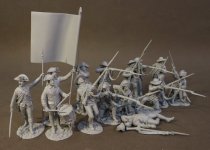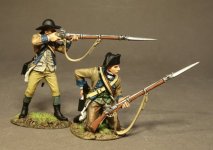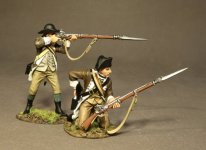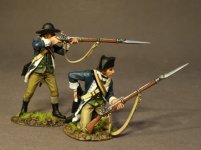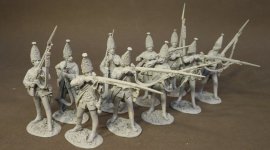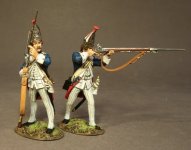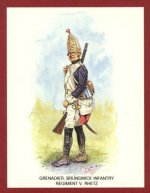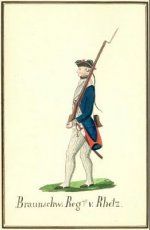NEW RELEASES FOR JUNE 2018
THE EIGHTEENTH CENTURY COLLECTION
DRUMS ALONG THE MOHAWK
THE BATTLE OF SARATOGA 1777,
ASSAULT ON THE BREYMANN REDOUBT, 7th October 1777
“The surrender that changed the world”.
In October 1777, a 6,000 strong British army surrendered in defeat after the American victory at the Battles of Saratoga.
For the first time in history a British General surrendered his sword.
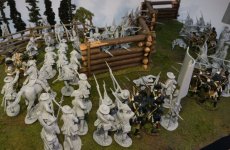
The German mercenaries were firing steadily from their redoubt.
From the rear came the crack of rifles. A general mounted and, his sword flashing, led the riflemen into the redoubt. German resistance collapsed. The Battle of Saratoga was over.
The day was Oct. 7th, 1777. Twelve days later, “Gentleman Johnny” Burgoyne, the gifted, courageous British commander, surrendered to the American general, Horatio Gates. Thus ended the most
ambitious and dangerous offensive launched by Britain in the Revolution. The attack on the redoubt was the last of a series of actions that constituted the Battle of Saratoga, considered the turning point of the Revolution.
The rifle fire that decimated the Germans awoke echoes around the World. The French court, friendly to any who fought their ancient British enemy, finally was convinced that France’s interest lay in entering the war on the side of the Americans.
Following intense fighting with the Continental Army in September, the British Army fortified themselves behind two defensive redoubts- the larger, better defended Balcarres Redoubt, and the weaker
Breymann Redoubt.
American forces, led by General Benedict Arnold, managed to take the Breymann Redoubt, which gave them a strong position behind the British lines. The loss of the Redoubt rendered the British position untenable. The British Army was forced to pull back to the river, from which position they would attempt to retreat north the next morning.

MORGAN’S RIFLEMEN
Morgan’s Riflemen or Morgan’s Rifles, were an elite light infantry unit Commanded by General Daniel morgan in the American Revolutionary War. It served a vital role, because it was equipped with what was then the cutting-edge rifle instead of muskets, allowing superior accuracy at up to ten times the distance of the typical muskets of the troops of the day.
The Riflemen proved pivotal in several engagements, and helped turn the main battle by attacking from the right flank, which was instrumental in taking the Breymann Redoubt.

SMG-03A
DRUMS ALONG THE MOHAWK,
THE BATTLE OF SARATOGA 1777,
MORGAN’S RIFLES,
2 RIFLEMEN SKIRMISHING ,
(2pcs)
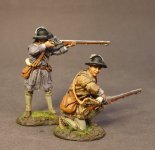
SMG-03B
DRUMS ALONG THE MOHAWK,
THE BATTLE OF SARATOGA 1777,
MORGAN’S RIFLES,
2 RIFLEMEN SKIRMISHING ,
(2pcs)
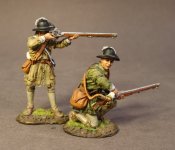
SMG-03C
DRUMS ALONG THE MOHAWK,
THE BATTLE OF SARATOGA 1777,
MORGAN’S RIFLES,
2 RIFLEMEN SKIRMISHING ,
(2pcs)
THE EIGHTEENTH CENTURY COLLECTION
DRUMS ALONG THE MOHAWK
THE BATTLE OF SARATOGA 1777,
ASSAULT ON THE BREYMANN REDOUBT, 7th October 1777
“The surrender that changed the world”.
In October 1777, a 6,000 strong British army surrendered in defeat after the American victory at the Battles of Saratoga.
For the first time in history a British General surrendered his sword.

The German mercenaries were firing steadily from their redoubt.
From the rear came the crack of rifles. A general mounted and, his sword flashing, led the riflemen into the redoubt. German resistance collapsed. The Battle of Saratoga was over.
The day was Oct. 7th, 1777. Twelve days later, “Gentleman Johnny” Burgoyne, the gifted, courageous British commander, surrendered to the American general, Horatio Gates. Thus ended the most
ambitious and dangerous offensive launched by Britain in the Revolution. The attack on the redoubt was the last of a series of actions that constituted the Battle of Saratoga, considered the turning point of the Revolution.
The rifle fire that decimated the Germans awoke echoes around the World. The French court, friendly to any who fought their ancient British enemy, finally was convinced that France’s interest lay in entering the war on the side of the Americans.
Following intense fighting with the Continental Army in September, the British Army fortified themselves behind two defensive redoubts- the larger, better defended Balcarres Redoubt, and the weaker
Breymann Redoubt.
American forces, led by General Benedict Arnold, managed to take the Breymann Redoubt, which gave them a strong position behind the British lines. The loss of the Redoubt rendered the British position untenable. The British Army was forced to pull back to the river, from which position they would attempt to retreat north the next morning.

MORGAN’S RIFLEMEN
Morgan’s Riflemen or Morgan’s Rifles, were an elite light infantry unit Commanded by General Daniel morgan in the American Revolutionary War. It served a vital role, because it was equipped with what was then the cutting-edge rifle instead of muskets, allowing superior accuracy at up to ten times the distance of the typical muskets of the troops of the day.
The Riflemen proved pivotal in several engagements, and helped turn the main battle by attacking from the right flank, which was instrumental in taking the Breymann Redoubt.

SMG-03A
DRUMS ALONG THE MOHAWK,
THE BATTLE OF SARATOGA 1777,
MORGAN’S RIFLES,
2 RIFLEMEN SKIRMISHING ,
(2pcs)

SMG-03B
DRUMS ALONG THE MOHAWK,
THE BATTLE OF SARATOGA 1777,
MORGAN’S RIFLES,
2 RIFLEMEN SKIRMISHING ,
(2pcs)

SMG-03C
DRUMS ALONG THE MOHAWK,
THE BATTLE OF SARATOGA 1777,
MORGAN’S RIFLES,
2 RIFLEMEN SKIRMISHING ,
(2pcs)


